Evaluating Uber's Ethical Practices in Business Operations
VerifiedAdded on 2020/05/16
|12
|4135
|188
Essay
AI Summary
This essay delves into Uber's aggressive expansion strategy and the ethical dilemmas it faces, particularly in classifying drivers as independent contractors rather than employees. This practice has sparked numerous legal and ethical controversies across various jurisdictions, highlighting conflicts between business objectives and regulatory compliance. The analysis explores how these issues impact stakeholders, including drivers, customers, and regulators, and evaluates Uber's corporate governance practices. Furthermore, the essay proposes potential resolutions to reconcile business growth with ethical considerations, emphasizing sustainable business models that respect stakeholder rights.
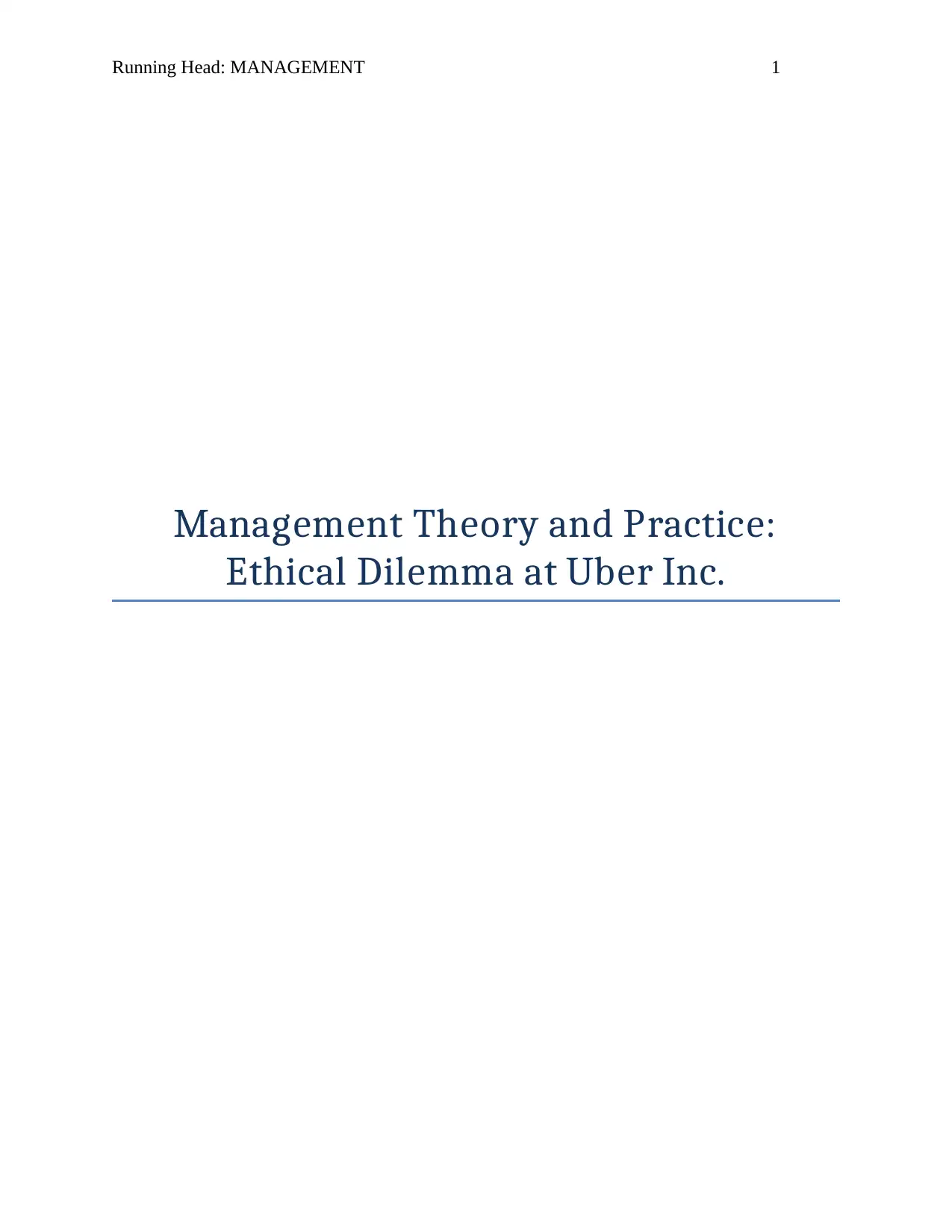
Running Head: MANAGEMENT 1
Management Theory and Practice:
Ethical Dilemma at Uber Inc.
Management Theory and Practice:
Ethical Dilemma at Uber Inc.
Paraphrase This Document
Need a fresh take? Get an instant paraphrase of this document with our AI Paraphraser
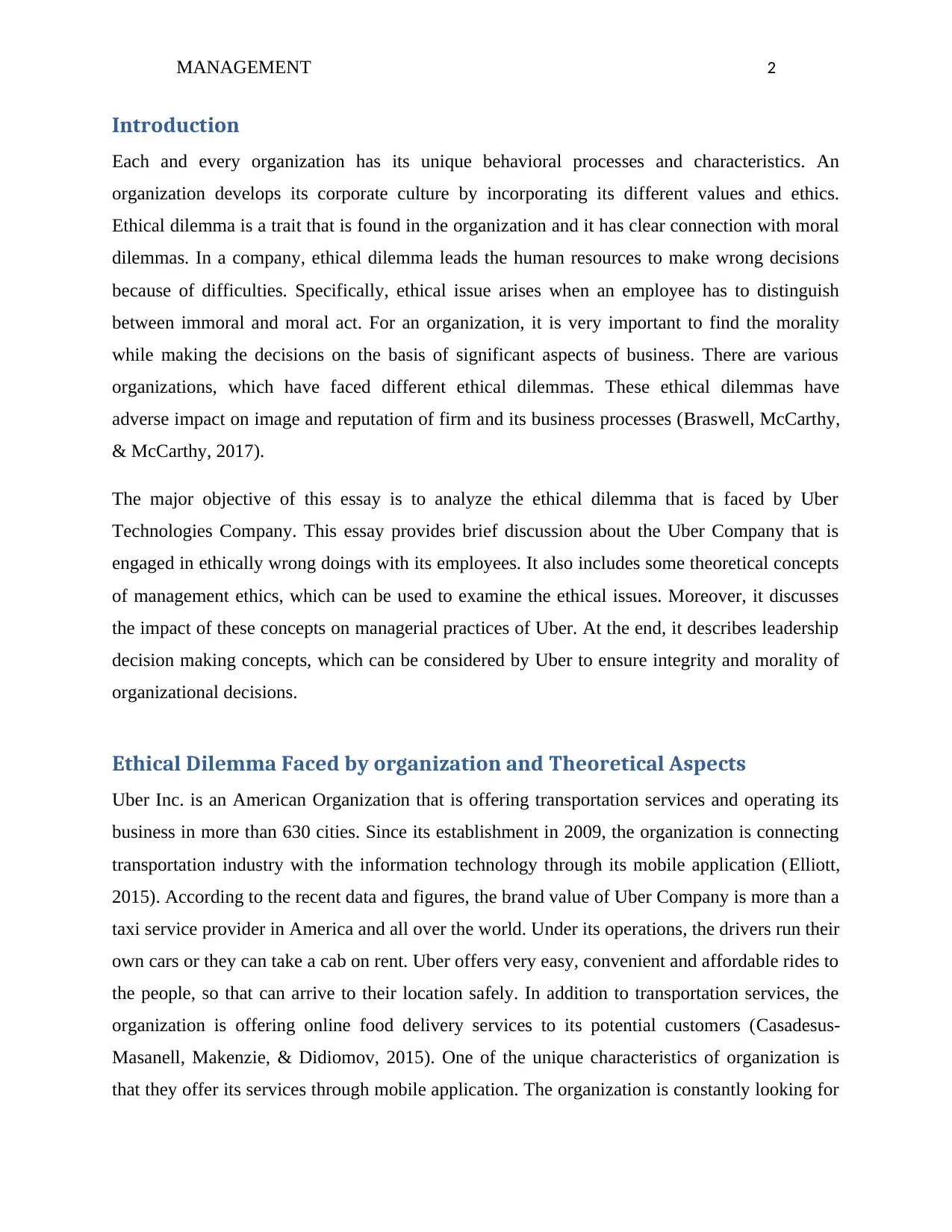
MANAGEMENT 2
Introduction
Each and every organization has its unique behavioral processes and characteristics. An
organization develops its corporate culture by incorporating its different values and ethics.
Ethical dilemma is a trait that is found in the organization and it has clear connection with moral
dilemmas. In a company, ethical dilemma leads the human resources to make wrong decisions
because of difficulties. Specifically, ethical issue arises when an employee has to distinguish
between immoral and moral act. For an organization, it is very important to find the morality
while making the decisions on the basis of significant aspects of business. There are various
organizations, which have faced different ethical dilemmas. These ethical dilemmas have
adverse impact on image and reputation of firm and its business processes (Braswell, McCarthy,
& McCarthy, 2017).
The major objective of this essay is to analyze the ethical dilemma that is faced by Uber
Technologies Company. This essay provides brief discussion about the Uber Company that is
engaged in ethically wrong doings with its employees. It also includes some theoretical concepts
of management ethics, which can be used to examine the ethical issues. Moreover, it discusses
the impact of these concepts on managerial practices of Uber. At the end, it describes leadership
decision making concepts, which can be considered by Uber to ensure integrity and morality of
organizational decisions.
Ethical Dilemma Faced by organization and Theoretical Aspects
Uber Inc. is an American Organization that is offering transportation services and operating its
business in more than 630 cities. Since its establishment in 2009, the organization is connecting
transportation industry with the information technology through its mobile application (Elliott,
2015). According to the recent data and figures, the brand value of Uber Company is more than a
taxi service provider in America and all over the world. Under its operations, the drivers run their
own cars or they can take a cab on rent. Uber offers very easy, convenient and affordable rides to
the people, so that can arrive to their location safely. In addition to transportation services, the
organization is offering online food delivery services to its potential customers (Casadesus-
Masanell, Makenzie, & Didiomov, 2015). One of the unique characteristics of organization is
that they offer its services through mobile application. The organization is constantly looking for
Introduction
Each and every organization has its unique behavioral processes and characteristics. An
organization develops its corporate culture by incorporating its different values and ethics.
Ethical dilemma is a trait that is found in the organization and it has clear connection with moral
dilemmas. In a company, ethical dilemma leads the human resources to make wrong decisions
because of difficulties. Specifically, ethical issue arises when an employee has to distinguish
between immoral and moral act. For an organization, it is very important to find the morality
while making the decisions on the basis of significant aspects of business. There are various
organizations, which have faced different ethical dilemmas. These ethical dilemmas have
adverse impact on image and reputation of firm and its business processes (Braswell, McCarthy,
& McCarthy, 2017).
The major objective of this essay is to analyze the ethical dilemma that is faced by Uber
Technologies Company. This essay provides brief discussion about the Uber Company that is
engaged in ethically wrong doings with its employees. It also includes some theoretical concepts
of management ethics, which can be used to examine the ethical issues. Moreover, it discusses
the impact of these concepts on managerial practices of Uber. At the end, it describes leadership
decision making concepts, which can be considered by Uber to ensure integrity and morality of
organizational decisions.
Ethical Dilemma Faced by organization and Theoretical Aspects
Uber Inc. is an American Organization that is offering transportation services and operating its
business in more than 630 cities. Since its establishment in 2009, the organization is connecting
transportation industry with the information technology through its mobile application (Elliott,
2015). According to the recent data and figures, the brand value of Uber Company is more than a
taxi service provider in America and all over the world. Under its operations, the drivers run their
own cars or they can take a cab on rent. Uber offers very easy, convenient and affordable rides to
the people, so that can arrive to their location safely. In addition to transportation services, the
organization is offering online food delivery services to its potential customers (Casadesus-
Masanell, Makenzie, & Didiomov, 2015). One of the unique characteristics of organization is
that they offer its services through mobile application. The organization is constantly looking for
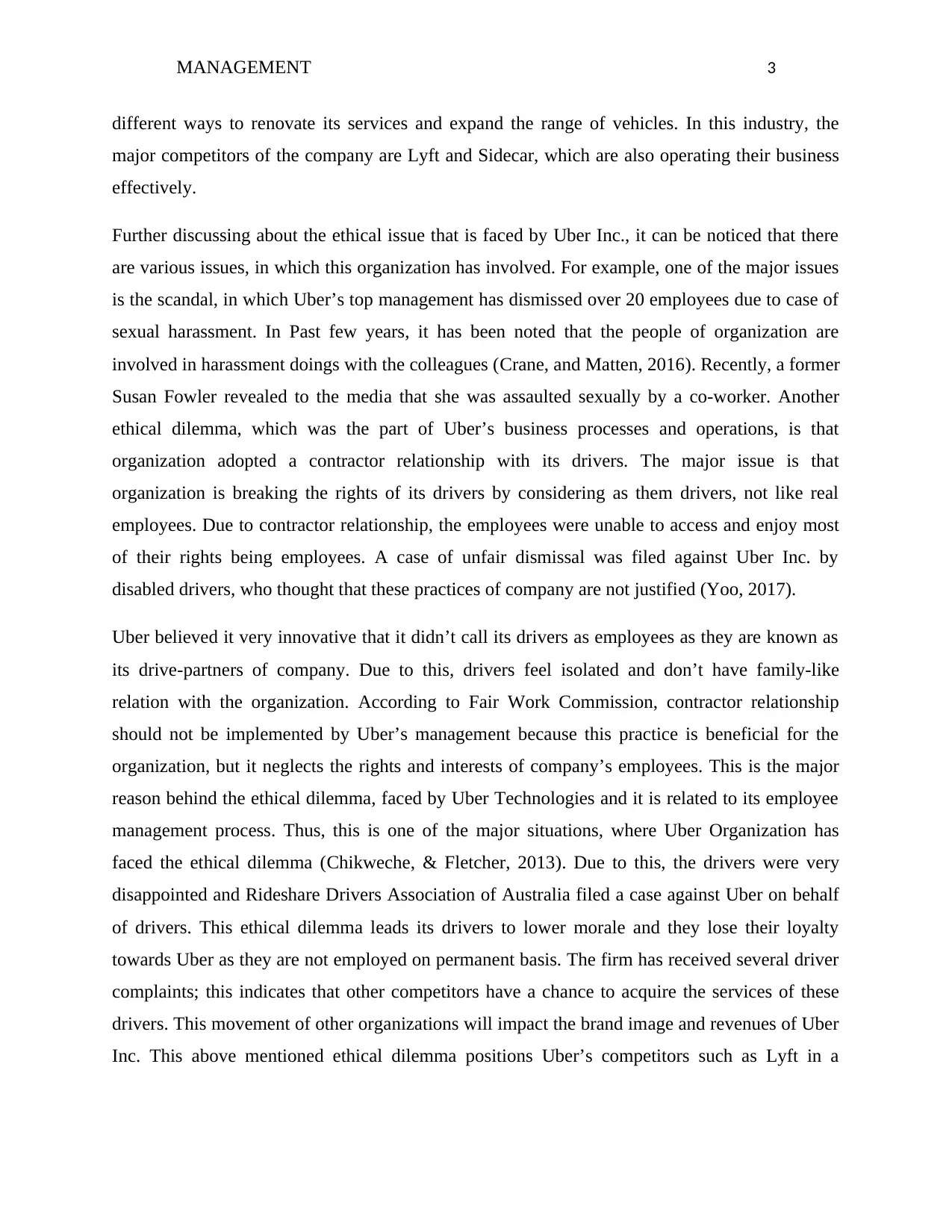
MANAGEMENT 3
different ways to renovate its services and expand the range of vehicles. In this industry, the
major competitors of the company are Lyft and Sidecar, which are also operating their business
effectively.
Further discussing about the ethical issue that is faced by Uber Inc., it can be noticed that there
are various issues, in which this organization has involved. For example, one of the major issues
is the scandal, in which Uber’s top management has dismissed over 20 employees due to case of
sexual harassment. In Past few years, it has been noted that the people of organization are
involved in harassment doings with the colleagues (Crane, and Matten, 2016). Recently, a former
Susan Fowler revealed to the media that she was assaulted sexually by a co-worker. Another
ethical dilemma, which was the part of Uber’s business processes and operations, is that
organization adopted a contractor relationship with its drivers. The major issue is that
organization is breaking the rights of its drivers by considering as them drivers, not like real
employees. Due to contractor relationship, the employees were unable to access and enjoy most
of their rights being employees. A case of unfair dismissal was filed against Uber Inc. by
disabled drivers, who thought that these practices of company are not justified (Yoo, 2017).
Uber believed it very innovative that it didn’t call its drivers as employees as they are known as
its drive-partners of company. Due to this, drivers feel isolated and don’t have family-like
relation with the organization. According to Fair Work Commission, contractor relationship
should not be implemented by Uber’s management because this practice is beneficial for the
organization, but it neglects the rights and interests of company’s employees. This is the major
reason behind the ethical dilemma, faced by Uber Technologies and it is related to its employee
management process. Thus, this is one of the major situations, where Uber Organization has
faced the ethical dilemma (Chikweche, & Fletcher, 2013). Due to this, the drivers were very
disappointed and Rideshare Drivers Association of Australia filed a case against Uber on behalf
of drivers. This ethical dilemma leads its drivers to lower morale and they lose their loyalty
towards Uber as they are not employed on permanent basis. The firm has received several driver
complaints; this indicates that other competitors have a chance to acquire the services of these
drivers. This movement of other organizations will impact the brand image and revenues of Uber
Inc. This above mentioned ethical dilemma positions Uber’s competitors such as Lyft in a
different ways to renovate its services and expand the range of vehicles. In this industry, the
major competitors of the company are Lyft and Sidecar, which are also operating their business
effectively.
Further discussing about the ethical issue that is faced by Uber Inc., it can be noticed that there
are various issues, in which this organization has involved. For example, one of the major issues
is the scandal, in which Uber’s top management has dismissed over 20 employees due to case of
sexual harassment. In Past few years, it has been noted that the people of organization are
involved in harassment doings with the colleagues (Crane, and Matten, 2016). Recently, a former
Susan Fowler revealed to the media that she was assaulted sexually by a co-worker. Another
ethical dilemma, which was the part of Uber’s business processes and operations, is that
organization adopted a contractor relationship with its drivers. The major issue is that
organization is breaking the rights of its drivers by considering as them drivers, not like real
employees. Due to contractor relationship, the employees were unable to access and enjoy most
of their rights being employees. A case of unfair dismissal was filed against Uber Inc. by
disabled drivers, who thought that these practices of company are not justified (Yoo, 2017).
Uber believed it very innovative that it didn’t call its drivers as employees as they are known as
its drive-partners of company. Due to this, drivers feel isolated and don’t have family-like
relation with the organization. According to Fair Work Commission, contractor relationship
should not be implemented by Uber’s management because this practice is beneficial for the
organization, but it neglects the rights and interests of company’s employees. This is the major
reason behind the ethical dilemma, faced by Uber Technologies and it is related to its employee
management process. Thus, this is one of the major situations, where Uber Organization has
faced the ethical dilemma (Chikweche, & Fletcher, 2013). Due to this, the drivers were very
disappointed and Rideshare Drivers Association of Australia filed a case against Uber on behalf
of drivers. This ethical dilemma leads its drivers to lower morale and they lose their loyalty
towards Uber as they are not employed on permanent basis. The firm has received several driver
complaints; this indicates that other competitors have a chance to acquire the services of these
drivers. This movement of other organizations will impact the brand image and revenues of Uber
Inc. This above mentioned ethical dilemma positions Uber’s competitors such as Lyft in a
⊘ This is a preview!⊘
Do you want full access?
Subscribe today to unlock all pages.

Trusted by 1+ million students worldwide
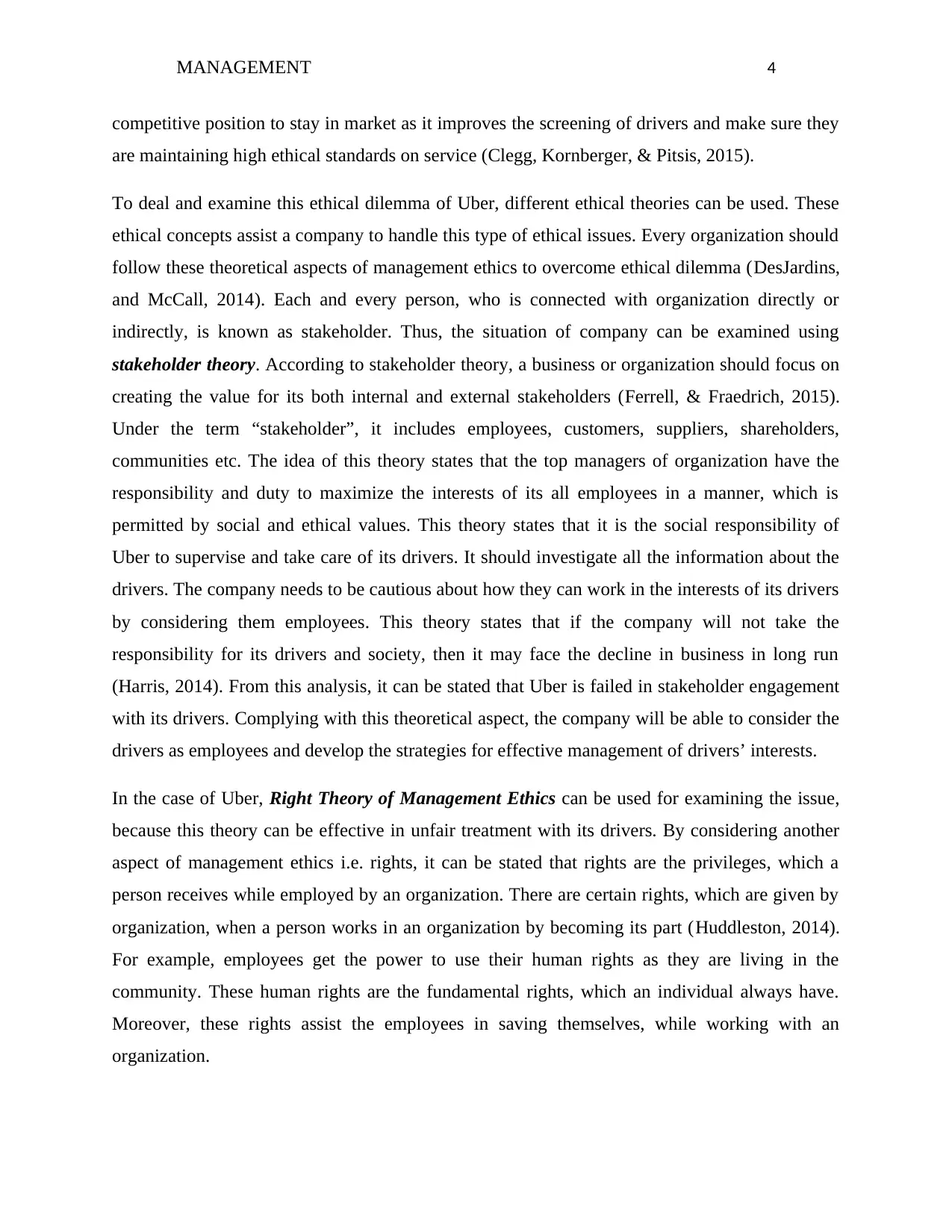
MANAGEMENT 4
competitive position to stay in market as it improves the screening of drivers and make sure they
are maintaining high ethical standards on service (Clegg, Kornberger, & Pitsis, 2015).
To deal and examine this ethical dilemma of Uber, different ethical theories can be used. These
ethical concepts assist a company to handle this type of ethical issues. Every organization should
follow these theoretical aspects of management ethics to overcome ethical dilemma (DesJardins,
and McCall, 2014). Each and every person, who is connected with organization directly or
indirectly, is known as stakeholder. Thus, the situation of company can be examined using
stakeholder theory. According to stakeholder theory, a business or organization should focus on
creating the value for its both internal and external stakeholders (Ferrell, & Fraedrich, 2015).
Under the term “stakeholder”, it includes employees, customers, suppliers, shareholders,
communities etc. The idea of this theory states that the top managers of organization have the
responsibility and duty to maximize the interests of its all employees in a manner, which is
permitted by social and ethical values. This theory states that it is the social responsibility of
Uber to supervise and take care of its drivers. It should investigate all the information about the
drivers. The company needs to be cautious about how they can work in the interests of its drivers
by considering them employees. This theory states that if the company will not take the
responsibility for its drivers and society, then it may face the decline in business in long run
(Harris, 2014). From this analysis, it can be stated that Uber is failed in stakeholder engagement
with its drivers. Complying with this theoretical aspect, the company will be able to consider the
drivers as employees and develop the strategies for effective management of drivers’ interests.
In the case of Uber, Right Theory of Management Ethics can be used for examining the issue,
because this theory can be effective in unfair treatment with its drivers. By considering another
aspect of management ethics i.e. rights, it can be stated that rights are the privileges, which a
person receives while employed by an organization. There are certain rights, which are given by
organization, when a person works in an organization by becoming its part (Huddleston, 2014).
For example, employees get the power to use their human rights as they are living in the
community. These human rights are the fundamental rights, which an individual always have.
Moreover, these rights assist the employees in saving themselves, while working with an
organization.
competitive position to stay in market as it improves the screening of drivers and make sure they
are maintaining high ethical standards on service (Clegg, Kornberger, & Pitsis, 2015).
To deal and examine this ethical dilemma of Uber, different ethical theories can be used. These
ethical concepts assist a company to handle this type of ethical issues. Every organization should
follow these theoretical aspects of management ethics to overcome ethical dilemma (DesJardins,
and McCall, 2014). Each and every person, who is connected with organization directly or
indirectly, is known as stakeholder. Thus, the situation of company can be examined using
stakeholder theory. According to stakeholder theory, a business or organization should focus on
creating the value for its both internal and external stakeholders (Ferrell, & Fraedrich, 2015).
Under the term “stakeholder”, it includes employees, customers, suppliers, shareholders,
communities etc. The idea of this theory states that the top managers of organization have the
responsibility and duty to maximize the interests of its all employees in a manner, which is
permitted by social and ethical values. This theory states that it is the social responsibility of
Uber to supervise and take care of its drivers. It should investigate all the information about the
drivers. The company needs to be cautious about how they can work in the interests of its drivers
by considering them employees. This theory states that if the company will not take the
responsibility for its drivers and society, then it may face the decline in business in long run
(Harris, 2014). From this analysis, it can be stated that Uber is failed in stakeholder engagement
with its drivers. Complying with this theoretical aspect, the company will be able to consider the
drivers as employees and develop the strategies for effective management of drivers’ interests.
In the case of Uber, Right Theory of Management Ethics can be used for examining the issue,
because this theory can be effective in unfair treatment with its drivers. By considering another
aspect of management ethics i.e. rights, it can be stated that rights are the privileges, which a
person receives while employed by an organization. There are certain rights, which are given by
organization, when a person works in an organization by becoming its part (Huddleston, 2014).
For example, employees get the power to use their human rights as they are living in the
community. These human rights are the fundamental rights, which an individual always have.
Moreover, these rights assist the employees in saving themselves, while working with an
organization.
Paraphrase This Document
Need a fresh take? Get an instant paraphrase of this document with our AI Paraphraser
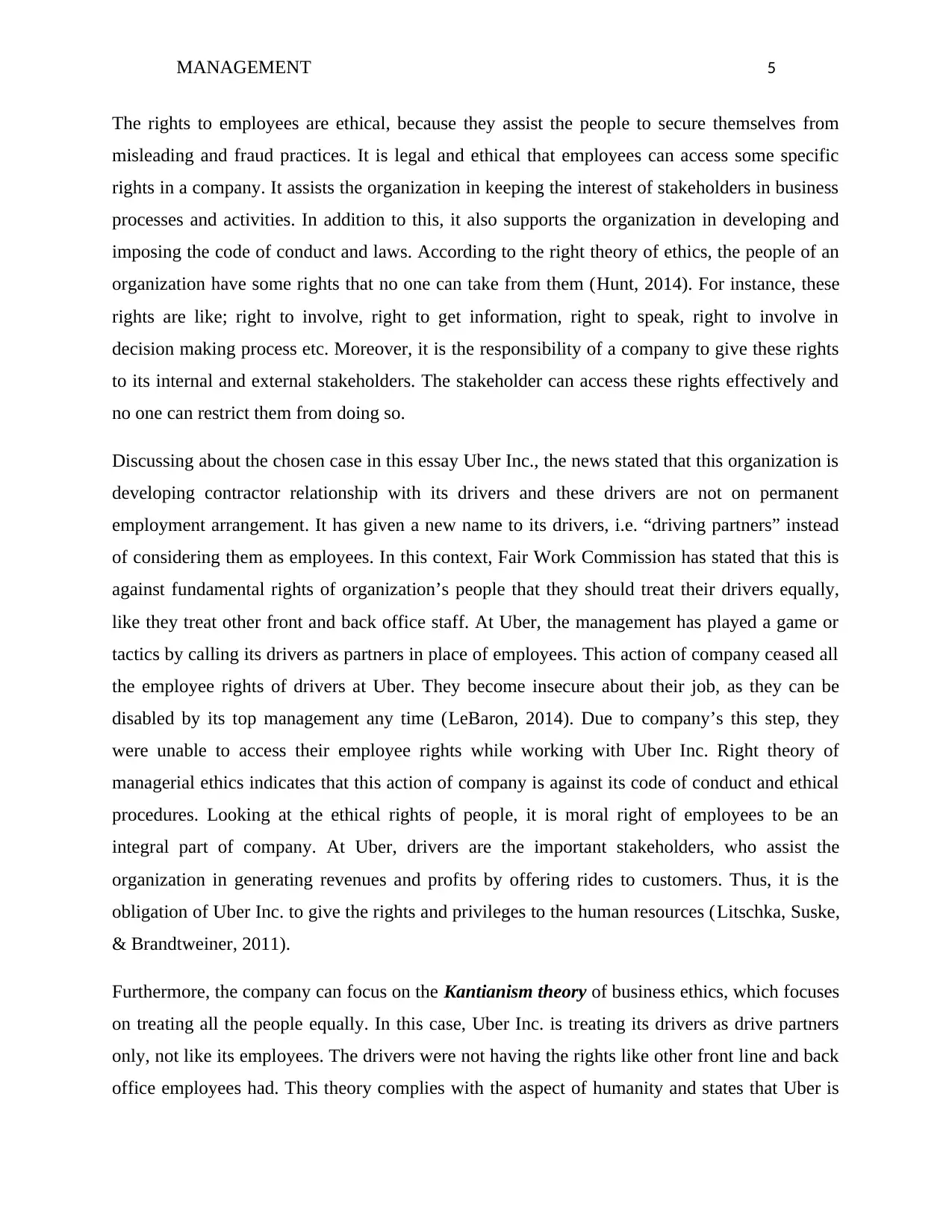
MANAGEMENT 5
The rights to employees are ethical, because they assist the people to secure themselves from
misleading and fraud practices. It is legal and ethical that employees can access some specific
rights in a company. It assists the organization in keeping the interest of stakeholders in business
processes and activities. In addition to this, it also supports the organization in developing and
imposing the code of conduct and laws. According to the right theory of ethics, the people of an
organization have some rights that no one can take from them (Hunt, 2014). For instance, these
rights are like; right to involve, right to get information, right to speak, right to involve in
decision making process etc. Moreover, it is the responsibility of a company to give these rights
to its internal and external stakeholders. The stakeholder can access these rights effectively and
no one can restrict them from doing so.
Discussing about the chosen case in this essay Uber Inc., the news stated that this organization is
developing contractor relationship with its drivers and these drivers are not on permanent
employment arrangement. It has given a new name to its drivers, i.e. “driving partners” instead
of considering them as employees. In this context, Fair Work Commission has stated that this is
against fundamental rights of organization’s people that they should treat their drivers equally,
like they treat other front and back office staff. At Uber, the management has played a game or
tactics by calling its drivers as partners in place of employees. This action of company ceased all
the employee rights of drivers at Uber. They become insecure about their job, as they can be
disabled by its top management any time (LeBaron, 2014). Due to company’s this step, they
were unable to access their employee rights while working with Uber Inc. Right theory of
managerial ethics indicates that this action of company is against its code of conduct and ethical
procedures. Looking at the ethical rights of people, it is moral right of employees to be an
integral part of company. At Uber, drivers are the important stakeholders, who assist the
organization in generating revenues and profits by offering rides to customers. Thus, it is the
obligation of Uber Inc. to give the rights and privileges to the human resources (Litschka, Suske,
& Brandtweiner, 2011).
Furthermore, the company can focus on the Kantianism theory of business ethics, which focuses
on treating all the people equally. In this case, Uber Inc. is treating its drivers as drive partners
only, not like its employees. The drivers were not having the rights like other front line and back
office employees had. This theory complies with the aspect of humanity and states that Uber is
The rights to employees are ethical, because they assist the people to secure themselves from
misleading and fraud practices. It is legal and ethical that employees can access some specific
rights in a company. It assists the organization in keeping the interest of stakeholders in business
processes and activities. In addition to this, it also supports the organization in developing and
imposing the code of conduct and laws. According to the right theory of ethics, the people of an
organization have some rights that no one can take from them (Hunt, 2014). For instance, these
rights are like; right to involve, right to get information, right to speak, right to involve in
decision making process etc. Moreover, it is the responsibility of a company to give these rights
to its internal and external stakeholders. The stakeholder can access these rights effectively and
no one can restrict them from doing so.
Discussing about the chosen case in this essay Uber Inc., the news stated that this organization is
developing contractor relationship with its drivers and these drivers are not on permanent
employment arrangement. It has given a new name to its drivers, i.e. “driving partners” instead
of considering them as employees. In this context, Fair Work Commission has stated that this is
against fundamental rights of organization’s people that they should treat their drivers equally,
like they treat other front and back office staff. At Uber, the management has played a game or
tactics by calling its drivers as partners in place of employees. This action of company ceased all
the employee rights of drivers at Uber. They become insecure about their job, as they can be
disabled by its top management any time (LeBaron, 2014). Due to company’s this step, they
were unable to access their employee rights while working with Uber Inc. Right theory of
managerial ethics indicates that this action of company is against its code of conduct and ethical
procedures. Looking at the ethical rights of people, it is moral right of employees to be an
integral part of company. At Uber, drivers are the important stakeholders, who assist the
organization in generating revenues and profits by offering rides to customers. Thus, it is the
obligation of Uber Inc. to give the rights and privileges to the human resources (Litschka, Suske,
& Brandtweiner, 2011).
Furthermore, the company can focus on the Kantianism theory of business ethics, which focuses
on treating all the people equally. In this case, Uber Inc. is treating its drivers as drive partners
only, not like its employees. The drivers were not having the rights like other front line and back
office employees had. This theory complies with the aspect of humanity and states that Uber is
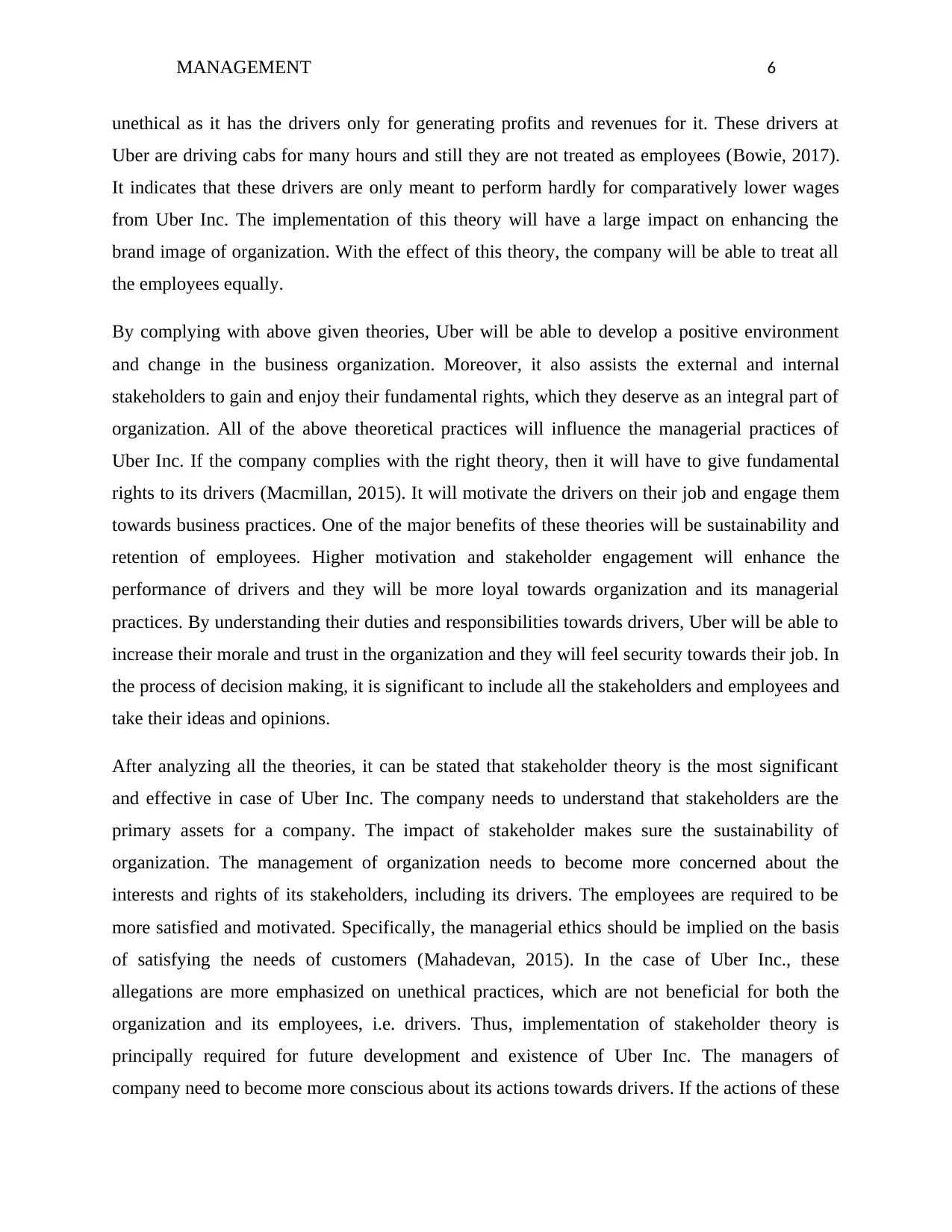
MANAGEMENT 6
unethical as it has the drivers only for generating profits and revenues for it. These drivers at
Uber are driving cabs for many hours and still they are not treated as employees (Bowie, 2017).
It indicates that these drivers are only meant to perform hardly for comparatively lower wages
from Uber Inc. The implementation of this theory will have a large impact on enhancing the
brand image of organization. With the effect of this theory, the company will be able to treat all
the employees equally.
By complying with above given theories, Uber will be able to develop a positive environment
and change in the business organization. Moreover, it also assists the external and internal
stakeholders to gain and enjoy their fundamental rights, which they deserve as an integral part of
organization. All of the above theoretical practices will influence the managerial practices of
Uber Inc. If the company complies with the right theory, then it will have to give fundamental
rights to its drivers (Macmillan, 2015). It will motivate the drivers on their job and engage them
towards business practices. One of the major benefits of these theories will be sustainability and
retention of employees. Higher motivation and stakeholder engagement will enhance the
performance of drivers and they will be more loyal towards organization and its managerial
practices. By understanding their duties and responsibilities towards drivers, Uber will be able to
increase their morale and trust in the organization and they will feel security towards their job. In
the process of decision making, it is significant to include all the stakeholders and employees and
take their ideas and opinions.
After analyzing all the theories, it can be stated that stakeholder theory is the most significant
and effective in case of Uber Inc. The company needs to understand that stakeholders are the
primary assets for a company. The impact of stakeholder makes sure the sustainability of
organization. The management of organization needs to become more concerned about the
interests and rights of its stakeholders, including its drivers. The employees are required to be
more satisfied and motivated. Specifically, the managerial ethics should be implied on the basis
of satisfying the needs of customers (Mahadevan, 2015). In the case of Uber Inc., these
allegations are more emphasized on unethical practices, which are not beneficial for both the
organization and its employees, i.e. drivers. Thus, implementation of stakeholder theory is
principally required for future development and existence of Uber Inc. The managers of
company need to become more conscious about its actions towards drivers. If the actions of these
unethical as it has the drivers only for generating profits and revenues for it. These drivers at
Uber are driving cabs for many hours and still they are not treated as employees (Bowie, 2017).
It indicates that these drivers are only meant to perform hardly for comparatively lower wages
from Uber Inc. The implementation of this theory will have a large impact on enhancing the
brand image of organization. With the effect of this theory, the company will be able to treat all
the employees equally.
By complying with above given theories, Uber will be able to develop a positive environment
and change in the business organization. Moreover, it also assists the external and internal
stakeholders to gain and enjoy their fundamental rights, which they deserve as an integral part of
organization. All of the above theoretical practices will influence the managerial practices of
Uber Inc. If the company complies with the right theory, then it will have to give fundamental
rights to its drivers (Macmillan, 2015). It will motivate the drivers on their job and engage them
towards business practices. One of the major benefits of these theories will be sustainability and
retention of employees. Higher motivation and stakeholder engagement will enhance the
performance of drivers and they will be more loyal towards organization and its managerial
practices. By understanding their duties and responsibilities towards drivers, Uber will be able to
increase their morale and trust in the organization and they will feel security towards their job. In
the process of decision making, it is significant to include all the stakeholders and employees and
take their ideas and opinions.
After analyzing all the theories, it can be stated that stakeholder theory is the most significant
and effective in case of Uber Inc. The company needs to understand that stakeholders are the
primary assets for a company. The impact of stakeholder makes sure the sustainability of
organization. The management of organization needs to become more concerned about the
interests and rights of its stakeholders, including its drivers. The employees are required to be
more satisfied and motivated. Specifically, the managerial ethics should be implied on the basis
of satisfying the needs of customers (Mahadevan, 2015). In the case of Uber Inc., these
allegations are more emphasized on unethical practices, which are not beneficial for both the
organization and its employees, i.e. drivers. Thus, implementation of stakeholder theory is
principally required for future development and existence of Uber Inc. The managers of
company need to become more conscious about its actions towards drivers. If the actions of these
⊘ This is a preview!⊘
Do you want full access?
Subscribe today to unlock all pages.

Trusted by 1+ million students worldwide
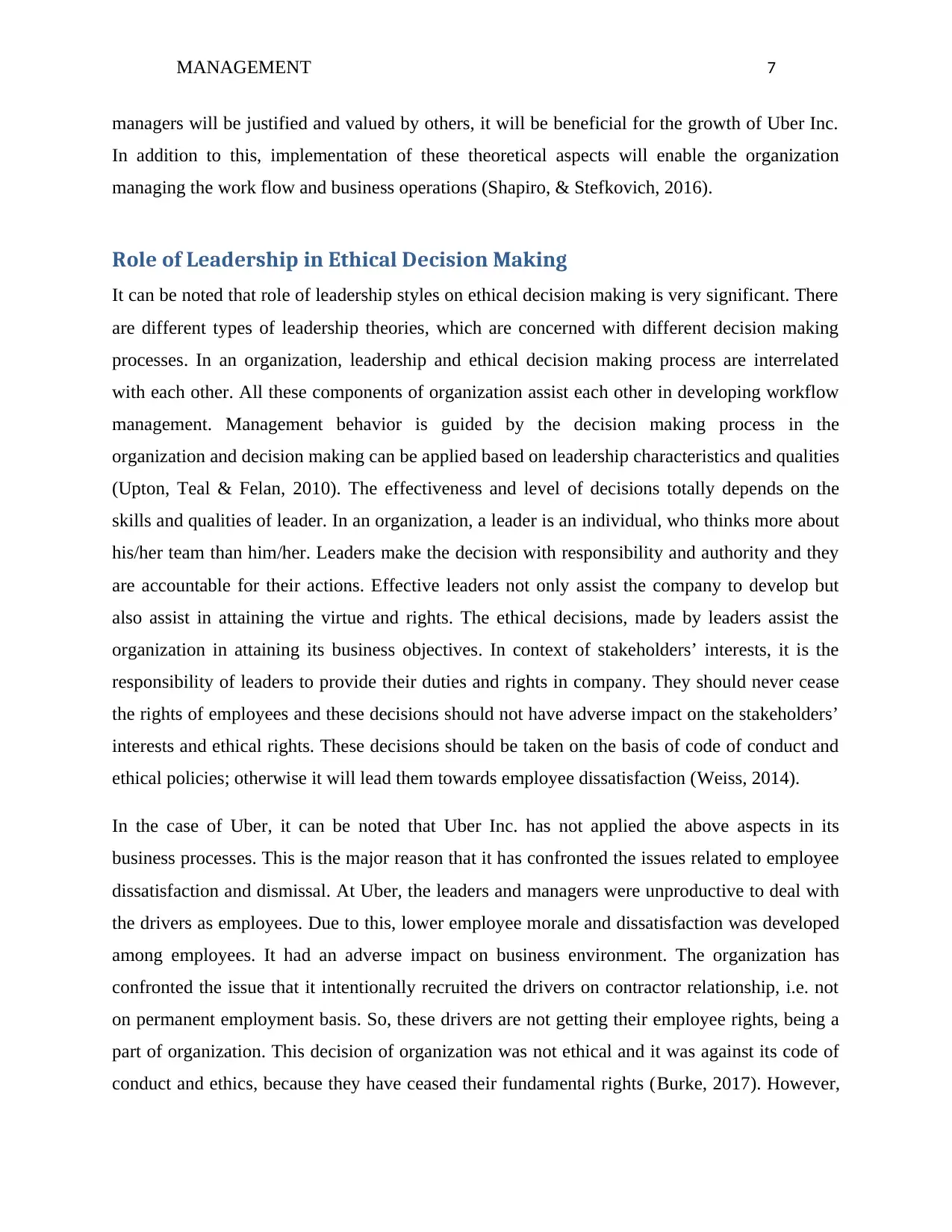
MANAGEMENT 7
managers will be justified and valued by others, it will be beneficial for the growth of Uber Inc.
In addition to this, implementation of these theoretical aspects will enable the organization
managing the work flow and business operations (Shapiro, & Stefkovich, 2016).
Role of Leadership in Ethical Decision Making
It can be noted that role of leadership styles on ethical decision making is very significant. There
are different types of leadership theories, which are concerned with different decision making
processes. In an organization, leadership and ethical decision making process are interrelated
with each other. All these components of organization assist each other in developing workflow
management. Management behavior is guided by the decision making process in the
organization and decision making can be applied based on leadership characteristics and qualities
(Upton, Teal & Felan, 2010). The effectiveness and level of decisions totally depends on the
skills and qualities of leader. In an organization, a leader is an individual, who thinks more about
his/her team than him/her. Leaders make the decision with responsibility and authority and they
are accountable for their actions. Effective leaders not only assist the company to develop but
also assist in attaining the virtue and rights. The ethical decisions, made by leaders assist the
organization in attaining its business objectives. In context of stakeholders’ interests, it is the
responsibility of leaders to provide their duties and rights in company. They should never cease
the rights of employees and these decisions should not have adverse impact on the stakeholders’
interests and ethical rights. These decisions should be taken on the basis of code of conduct and
ethical policies; otherwise it will lead them towards employee dissatisfaction (Weiss, 2014).
In the case of Uber, it can be noted that Uber Inc. has not applied the above aspects in its
business processes. This is the major reason that it has confronted the issues related to employee
dissatisfaction and dismissal. At Uber, the leaders and managers were unproductive to deal with
the drivers as employees. Due to this, lower employee morale and dissatisfaction was developed
among employees. It had an adverse impact on business environment. The organization has
confronted the issue that it intentionally recruited the drivers on contractor relationship, i.e. not
on permanent employment basis. So, these drivers are not getting their employee rights, being a
part of organization. This decision of organization was not ethical and it was against its code of
conduct and ethics, because they have ceased their fundamental rights (Burke, 2017). However,
managers will be justified and valued by others, it will be beneficial for the growth of Uber Inc.
In addition to this, implementation of these theoretical aspects will enable the organization
managing the work flow and business operations (Shapiro, & Stefkovich, 2016).
Role of Leadership in Ethical Decision Making
It can be noted that role of leadership styles on ethical decision making is very significant. There
are different types of leadership theories, which are concerned with different decision making
processes. In an organization, leadership and ethical decision making process are interrelated
with each other. All these components of organization assist each other in developing workflow
management. Management behavior is guided by the decision making process in the
organization and decision making can be applied based on leadership characteristics and qualities
(Upton, Teal & Felan, 2010). The effectiveness and level of decisions totally depends on the
skills and qualities of leader. In an organization, a leader is an individual, who thinks more about
his/her team than him/her. Leaders make the decision with responsibility and authority and they
are accountable for their actions. Effective leaders not only assist the company to develop but
also assist in attaining the virtue and rights. The ethical decisions, made by leaders assist the
organization in attaining its business objectives. In context of stakeholders’ interests, it is the
responsibility of leaders to provide their duties and rights in company. They should never cease
the rights of employees and these decisions should not have adverse impact on the stakeholders’
interests and ethical rights. These decisions should be taken on the basis of code of conduct and
ethical policies; otherwise it will lead them towards employee dissatisfaction (Weiss, 2014).
In the case of Uber, it can be noted that Uber Inc. has not applied the above aspects in its
business processes. This is the major reason that it has confronted the issues related to employee
dissatisfaction and dismissal. At Uber, the leaders and managers were unproductive to deal with
the drivers as employees. Due to this, lower employee morale and dissatisfaction was developed
among employees. It had an adverse impact on business environment. The organization has
confronted the issue that it intentionally recruited the drivers on contractor relationship, i.e. not
on permanent employment basis. So, these drivers are not getting their employee rights, being a
part of organization. This decision of organization was not ethical and it was against its code of
conduct and ethics, because they have ceased their fundamental rights (Burke, 2017). However,
Paraphrase This Document
Need a fresh take? Get an instant paraphrase of this document with our AI Paraphraser
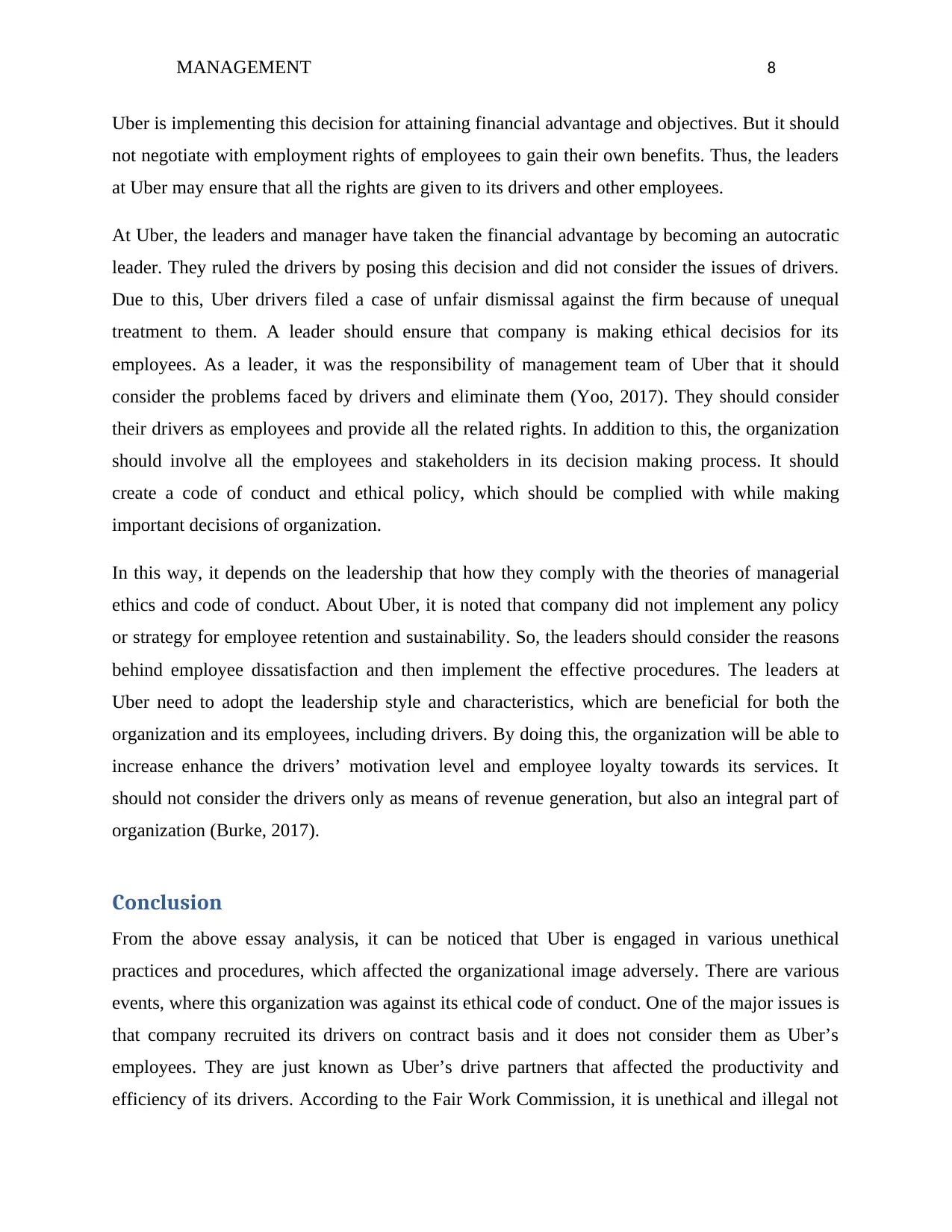
MANAGEMENT 8
Uber is implementing this decision for attaining financial advantage and objectives. But it should
not negotiate with employment rights of employees to gain their own benefits. Thus, the leaders
at Uber may ensure that all the rights are given to its drivers and other employees.
At Uber, the leaders and manager have taken the financial advantage by becoming an autocratic
leader. They ruled the drivers by posing this decision and did not consider the issues of drivers.
Due to this, Uber drivers filed a case of unfair dismissal against the firm because of unequal
treatment to them. A leader should ensure that company is making ethical decisios for its
employees. As a leader, it was the responsibility of management team of Uber that it should
consider the problems faced by drivers and eliminate them (Yoo, 2017). They should consider
their drivers as employees and provide all the related rights. In addition to this, the organization
should involve all the employees and stakeholders in its decision making process. It should
create a code of conduct and ethical policy, which should be complied with while making
important decisions of organization.
In this way, it depends on the leadership that how they comply with the theories of managerial
ethics and code of conduct. About Uber, it is noted that company did not implement any policy
or strategy for employee retention and sustainability. So, the leaders should consider the reasons
behind employee dissatisfaction and then implement the effective procedures. The leaders at
Uber need to adopt the leadership style and characteristics, which are beneficial for both the
organization and its employees, including drivers. By doing this, the organization will be able to
increase enhance the drivers’ motivation level and employee loyalty towards its services. It
should not consider the drivers only as means of revenue generation, but also an integral part of
organization (Burke, 2017).
Conclusion
From the above essay analysis, it can be noticed that Uber is engaged in various unethical
practices and procedures, which affected the organizational image adversely. There are various
events, where this organization was against its ethical code of conduct. One of the major issues is
that company recruited its drivers on contract basis and it does not consider them as Uber’s
employees. They are just known as Uber’s drive partners that affected the productivity and
efficiency of its drivers. According to the Fair Work Commission, it is unethical and illegal not
Uber is implementing this decision for attaining financial advantage and objectives. But it should
not negotiate with employment rights of employees to gain their own benefits. Thus, the leaders
at Uber may ensure that all the rights are given to its drivers and other employees.
At Uber, the leaders and manager have taken the financial advantage by becoming an autocratic
leader. They ruled the drivers by posing this decision and did not consider the issues of drivers.
Due to this, Uber drivers filed a case of unfair dismissal against the firm because of unequal
treatment to them. A leader should ensure that company is making ethical decisios for its
employees. As a leader, it was the responsibility of management team of Uber that it should
consider the problems faced by drivers and eliminate them (Yoo, 2017). They should consider
their drivers as employees and provide all the related rights. In addition to this, the organization
should involve all the employees and stakeholders in its decision making process. It should
create a code of conduct and ethical policy, which should be complied with while making
important decisions of organization.
In this way, it depends on the leadership that how they comply with the theories of managerial
ethics and code of conduct. About Uber, it is noted that company did not implement any policy
or strategy for employee retention and sustainability. So, the leaders should consider the reasons
behind employee dissatisfaction and then implement the effective procedures. The leaders at
Uber need to adopt the leadership style and characteristics, which are beneficial for both the
organization and its employees, including drivers. By doing this, the organization will be able to
increase enhance the drivers’ motivation level and employee loyalty towards its services. It
should not consider the drivers only as means of revenue generation, but also an integral part of
organization (Burke, 2017).
Conclusion
From the above essay analysis, it can be noticed that Uber is engaged in various unethical
practices and procedures, which affected the organizational image adversely. There are various
events, where this organization was against its ethical code of conduct. One of the major issues is
that company recruited its drivers on contract basis and it does not consider them as Uber’s
employees. They are just known as Uber’s drive partners that affected the productivity and
efficiency of its drivers. According to the Fair Work Commission, it is unethical and illegal not
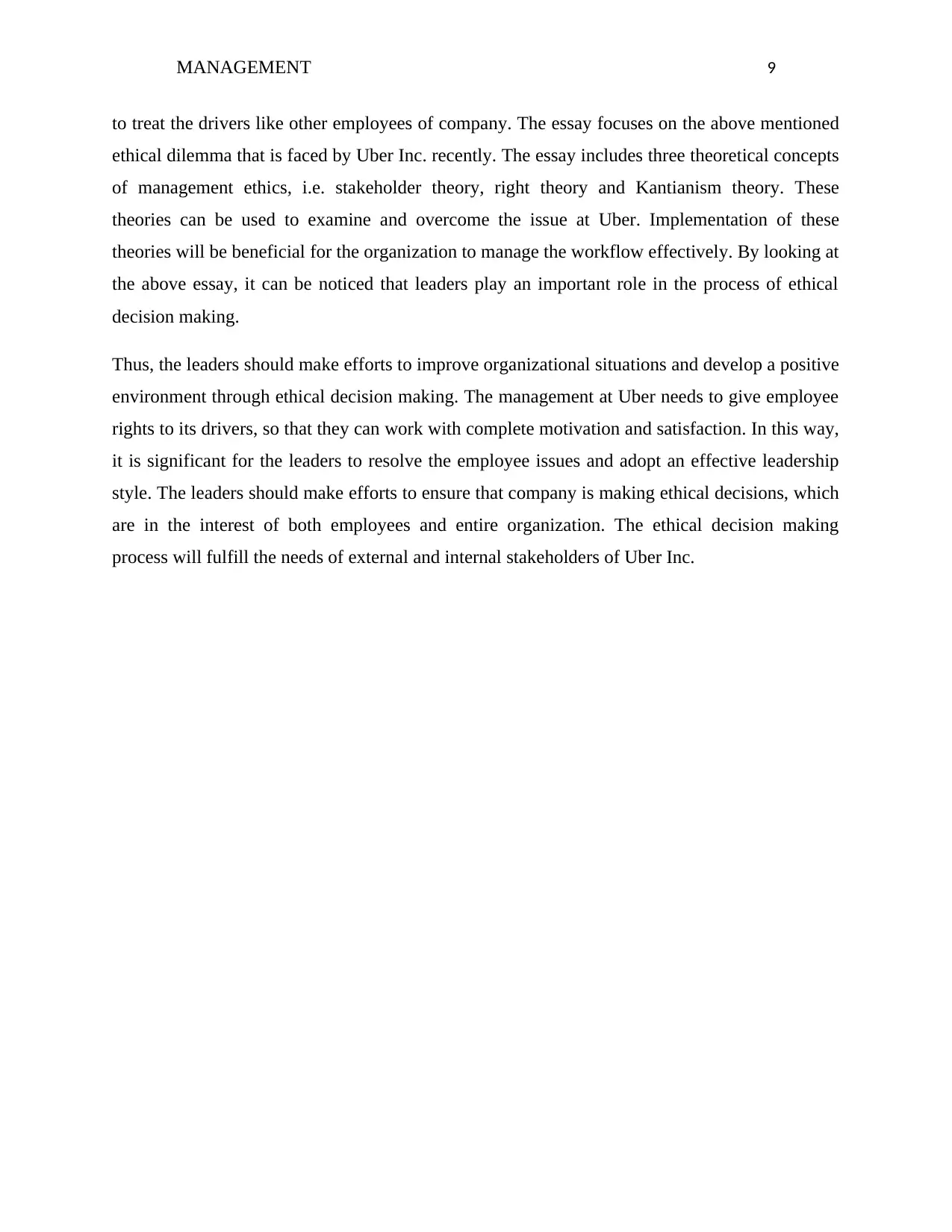
MANAGEMENT 9
to treat the drivers like other employees of company. The essay focuses on the above mentioned
ethical dilemma that is faced by Uber Inc. recently. The essay includes three theoretical concepts
of management ethics, i.e. stakeholder theory, right theory and Kantianism theory. These
theories can be used to examine and overcome the issue at Uber. Implementation of these
theories will be beneficial for the organization to manage the workflow effectively. By looking at
the above essay, it can be noticed that leaders play an important role in the process of ethical
decision making.
Thus, the leaders should make efforts to improve organizational situations and develop a positive
environment through ethical decision making. The management at Uber needs to give employee
rights to its drivers, so that they can work with complete motivation and satisfaction. In this way,
it is significant for the leaders to resolve the employee issues and adopt an effective leadership
style. The leaders should make efforts to ensure that company is making ethical decisions, which
are in the interest of both employees and entire organization. The ethical decision making
process will fulfill the needs of external and internal stakeholders of Uber Inc.
to treat the drivers like other employees of company. The essay focuses on the above mentioned
ethical dilemma that is faced by Uber Inc. recently. The essay includes three theoretical concepts
of management ethics, i.e. stakeholder theory, right theory and Kantianism theory. These
theories can be used to examine and overcome the issue at Uber. Implementation of these
theories will be beneficial for the organization to manage the workflow effectively. By looking at
the above essay, it can be noticed that leaders play an important role in the process of ethical
decision making.
Thus, the leaders should make efforts to improve organizational situations and develop a positive
environment through ethical decision making. The management at Uber needs to give employee
rights to its drivers, so that they can work with complete motivation and satisfaction. In this way,
it is significant for the leaders to resolve the employee issues and adopt an effective leadership
style. The leaders should make efforts to ensure that company is making ethical decisions, which
are in the interest of both employees and entire organization. The ethical decision making
process will fulfill the needs of external and internal stakeholders of Uber Inc.
⊘ This is a preview!⊘
Do you want full access?
Subscribe today to unlock all pages.

Trusted by 1+ million students worldwide
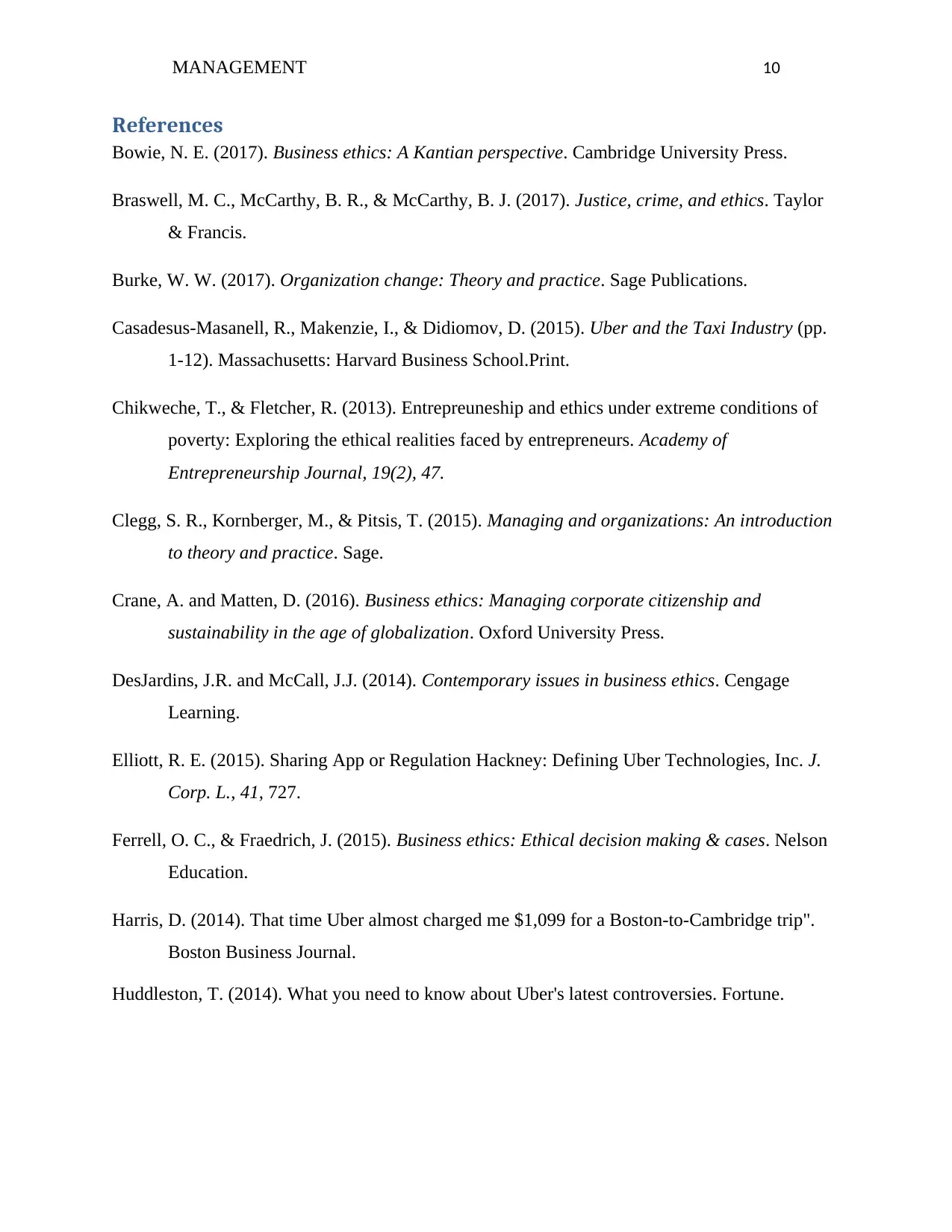
MANAGEMENT 10
References
Bowie, N. E. (2017). Business ethics: A Kantian perspective. Cambridge University Press.
Braswell, M. C., McCarthy, B. R., & McCarthy, B. J. (2017). Justice, crime, and ethics. Taylor
& Francis.
Burke, W. W. (2017). Organization change: Theory and practice. Sage Publications.
Casadesus-Masanell, R., Makenzie, I., & Didiomov, D. (2015). Uber and the Taxi Industry (pp.
1-12). Massachusetts: Harvard Business School.Print.
Chikweche, T., & Fletcher, R. (2013). Entrepreuneship and ethics under extreme conditions of
poverty: Exploring the ethical realities faced by entrepreneurs. Academy of
Entrepreneurship Journal, 19(2), 47.
Clegg, S. R., Kornberger, M., & Pitsis, T. (2015). Managing and organizations: An introduction
to theory and practice. Sage.
Crane, A. and Matten, D. (2016). Business ethics: Managing corporate citizenship and
sustainability in the age of globalization. Oxford University Press.
DesJardins, J.R. and McCall, J.J. (2014). Contemporary issues in business ethics. Cengage
Learning.
Elliott, R. E. (2015). Sharing App or Regulation Hackney: Defining Uber Technologies, Inc. J.
Corp. L., 41, 727.
Ferrell, O. C., & Fraedrich, J. (2015). Business ethics: Ethical decision making & cases. Nelson
Education.
Harris, D. (2014). That time Uber almost charged me $1,099 for a Boston-to-Cambridge trip".
Boston Business Journal.
Huddleston, T. (2014). What you need to know about Uber's latest controversies. Fortune.
References
Bowie, N. E. (2017). Business ethics: A Kantian perspective. Cambridge University Press.
Braswell, M. C., McCarthy, B. R., & McCarthy, B. J. (2017). Justice, crime, and ethics. Taylor
& Francis.
Burke, W. W. (2017). Organization change: Theory and practice. Sage Publications.
Casadesus-Masanell, R., Makenzie, I., & Didiomov, D. (2015). Uber and the Taxi Industry (pp.
1-12). Massachusetts: Harvard Business School.Print.
Chikweche, T., & Fletcher, R. (2013). Entrepreuneship and ethics under extreme conditions of
poverty: Exploring the ethical realities faced by entrepreneurs. Academy of
Entrepreneurship Journal, 19(2), 47.
Clegg, S. R., Kornberger, M., & Pitsis, T. (2015). Managing and organizations: An introduction
to theory and practice. Sage.
Crane, A. and Matten, D. (2016). Business ethics: Managing corporate citizenship and
sustainability in the age of globalization. Oxford University Press.
DesJardins, J.R. and McCall, J.J. (2014). Contemporary issues in business ethics. Cengage
Learning.
Elliott, R. E. (2015). Sharing App or Regulation Hackney: Defining Uber Technologies, Inc. J.
Corp. L., 41, 727.
Ferrell, O. C., & Fraedrich, J. (2015). Business ethics: Ethical decision making & cases. Nelson
Education.
Harris, D. (2014). That time Uber almost charged me $1,099 for a Boston-to-Cambridge trip".
Boston Business Journal.
Huddleston, T. (2014). What you need to know about Uber's latest controversies. Fortune.
Paraphrase This Document
Need a fresh take? Get an instant paraphrase of this document with our AI Paraphraser
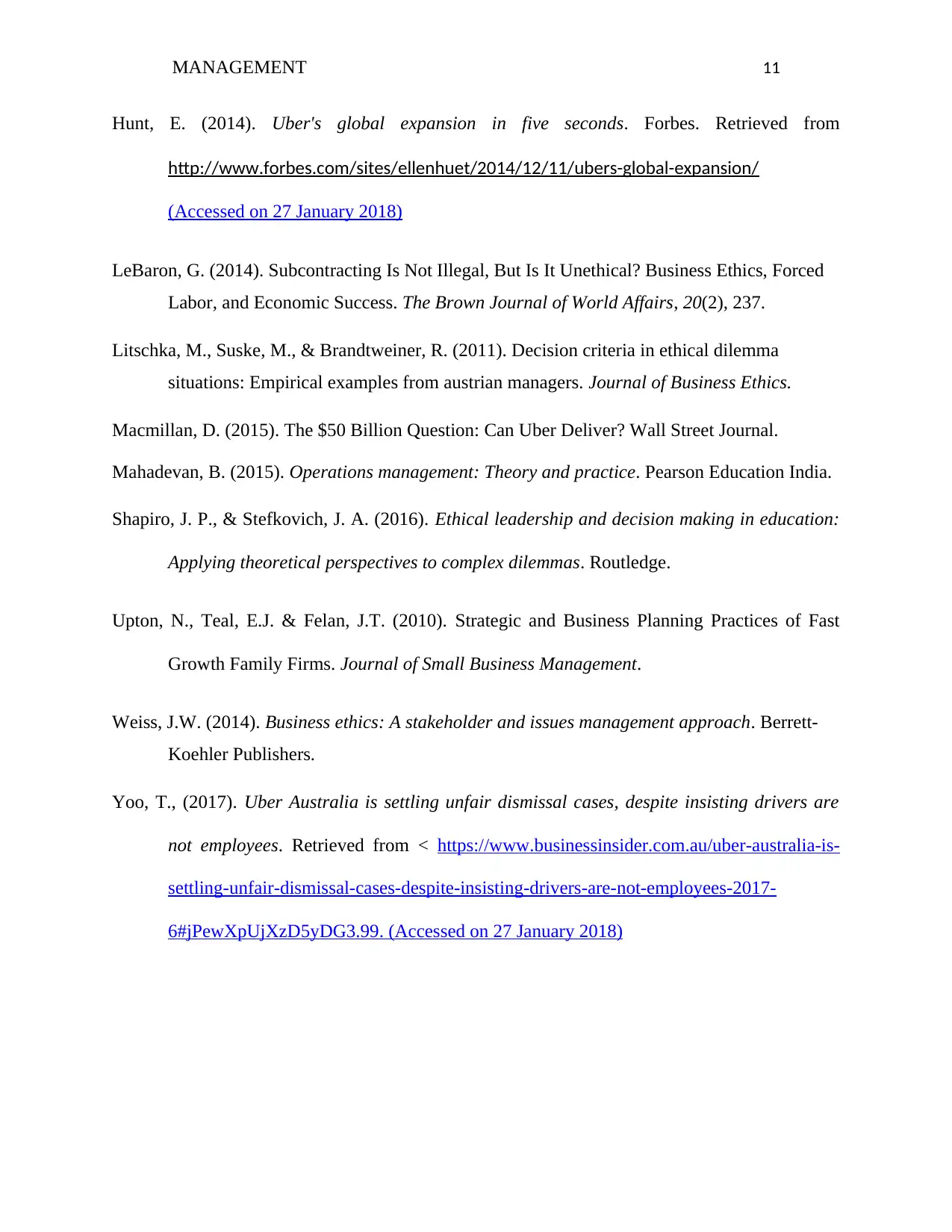
MANAGEMENT 11
Hunt, E. (2014). Uber's global expansion in five seconds. Forbes. Retrieved from
http://www.forbes.com/sites/ellenhuet/2014/12/11/ubers-global-expansion/
(Accessed on 27 January 2018)
LeBaron, G. (2014). Subcontracting Is Not Illegal, But Is It Unethical? Business Ethics, Forced
Labor, and Economic Success. The Brown Journal of World Affairs, 20(2), 237.
Litschka, M., Suske, M., & Brandtweiner, R. (2011). Decision criteria in ethical dilemma
situations: Empirical examples from austrian managers. Journal of Business Ethics.
Macmillan, D. (2015). The $50 Billion Question: Can Uber Deliver? Wall Street Journal.
Mahadevan, B. (2015). Operations management: Theory and practice. Pearson Education India.
Shapiro, J. P., & Stefkovich, J. A. (2016). Ethical leadership and decision making in education:
Applying theoretical perspectives to complex dilemmas. Routledge.
Upton, N., Teal, E.J. & Felan, J.T. (2010). Strategic and Business Planning Practices of Fast
Growth Family Firms. Journal of Small Business Management.
Weiss, J.W. (2014). Business ethics: A stakeholder and issues management approach. Berrett-
Koehler Publishers.
Yoo, T., (2017). Uber Australia is settling unfair dismissal cases, despite insisting drivers are
not employees. Retrieved from < https://www.businessinsider.com.au/uber-australia-is-
settling-unfair-dismissal-cases-despite-insisting-drivers-are-not-employees-2017-
6#jPewXpUjXzD5yDG3.99. (Accessed on 27 January 2018)
Hunt, E. (2014). Uber's global expansion in five seconds. Forbes. Retrieved from
http://www.forbes.com/sites/ellenhuet/2014/12/11/ubers-global-expansion/
(Accessed on 27 January 2018)
LeBaron, G. (2014). Subcontracting Is Not Illegal, But Is It Unethical? Business Ethics, Forced
Labor, and Economic Success. The Brown Journal of World Affairs, 20(2), 237.
Litschka, M., Suske, M., & Brandtweiner, R. (2011). Decision criteria in ethical dilemma
situations: Empirical examples from austrian managers. Journal of Business Ethics.
Macmillan, D. (2015). The $50 Billion Question: Can Uber Deliver? Wall Street Journal.
Mahadevan, B. (2015). Operations management: Theory and practice. Pearson Education India.
Shapiro, J. P., & Stefkovich, J. A. (2016). Ethical leadership and decision making in education:
Applying theoretical perspectives to complex dilemmas. Routledge.
Upton, N., Teal, E.J. & Felan, J.T. (2010). Strategic and Business Planning Practices of Fast
Growth Family Firms. Journal of Small Business Management.
Weiss, J.W. (2014). Business ethics: A stakeholder and issues management approach. Berrett-
Koehler Publishers.
Yoo, T., (2017). Uber Australia is settling unfair dismissal cases, despite insisting drivers are
not employees. Retrieved from < https://www.businessinsider.com.au/uber-australia-is-
settling-unfair-dismissal-cases-despite-insisting-drivers-are-not-employees-2017-
6#jPewXpUjXzD5yDG3.99. (Accessed on 27 January 2018)
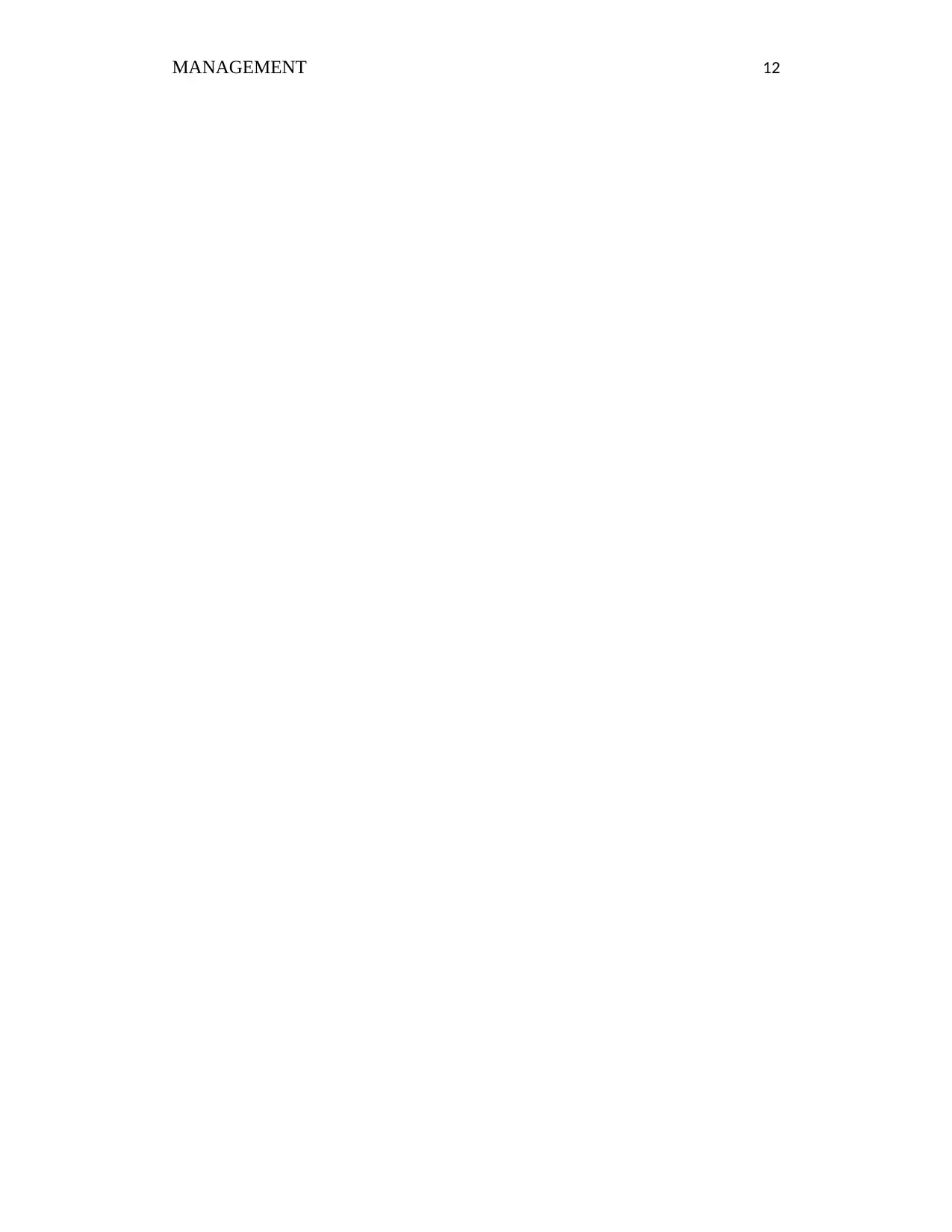
MANAGEMENT 12
⊘ This is a preview!⊘
Do you want full access?
Subscribe today to unlock all pages.

Trusted by 1+ million students worldwide
1 out of 12
Related Documents
Your All-in-One AI-Powered Toolkit for Academic Success.
+13062052269
info@desklib.com
Available 24*7 on WhatsApp / Email
![[object Object]](/_next/static/media/star-bottom.7253800d.svg)
Unlock your academic potential
Copyright © 2020–2025 A2Z Services. All Rights Reserved. Developed and managed by ZUCOL.





